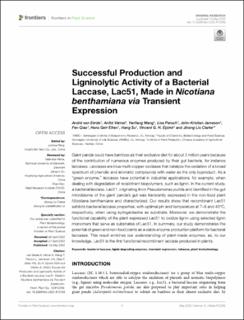| dc.contributor.author | van Eerde, André | |
| dc.contributor.author | Varnai, Aniko | |
| dc.contributor.author | Wang, Yanliang | |
| dc.contributor.author | Paruch, Lisa | |
| dc.contributor.author | Jameson, John-Kristian | |
| dc.contributor.author | Qiao, Fen | |
| dc.contributor.author | Eiken, Hans Geir | |
| dc.contributor.author | Su, Hang | |
| dc.contributor.author | Eijsink, Vincent | |
| dc.contributor.author | Clarke, Jihong Liu | |
| dc.date.accessioned | 2023-04-03T12:20:45Z | |
| dc.date.available | 2023-04-03T12:20:45Z | |
| dc.date.created | 2022-05-03T14:00:52Z | |
| dc.date.issued | 2022-05-13 | |
| dc.identifier.citation | Frontiers in Plant Science. 2022, 13 1-10. | en_US |
| dc.identifier.issn | 1664-462X | |
| dc.identifier.uri | https://hdl.handle.net/11250/3061845 | |
| dc.description.abstract | Giant panda could have bamboo as their exclusive diet for about 2 million years because of the contribution of numerous enzymes produced by their gut bacteria, for instance laccases. Laccases are blue multi-copper oxidases that catalyze the oxidation of a broad spectrum of phenolic and aromatic compounds with water as the only byproduct. As a “green enzyme,” laccases have potential in industrial applications, for example, when dealing with degradation of recalcitrant biopolymers, such as lignin. In the current study, a bacterial laccase, Lac51, originating from Pseudomonas putida and identified in the gut microbiome of the giant panda’s gut was transiently expressed in the non-food plant Nicotiana benthamiana and characterized. Our results show that recombinant Lac51 exhibits bacterial laccase properties, with optimal pH and temperature at 7–8 and 40°C, respectively, when using syringaldazine as substrate. Moreover, we demonstrate the functional capability of the plant expressed Lac51 to oxidize lignin using selected lignin monomers that serve as substrates of Lac51. In summary, our study demonstrates the potential of green and non-food plants as a viable enzyme production platform for bacterial laccases. This result enriches our understanding of plant-made enzymes, as, to our knowledge, Lac51 is the first functional recombinant laccase produced in plants. | en_US |
| dc.language.iso | eng | en_US |
| dc.publisher | Frontiers Media | en_US |
| dc.rights | Navngivelse 4.0 Internasjonal | * |
| dc.rights.uri | http://creativecommons.org/licenses/by/4.0/deed.no | * |
| dc.title | Successful Production and Ligninolytic Activity of a Bacterial Laccase, Lac51, Made in Nicotiana benthamiana via Transient Expression | en_US |
| dc.title.alternative | Successful Production and Ligninolytic Activity of a Bacterial Laccase, Lac51, Made in Nicotiana benthamiana via Transient Expression | en_US |
| dc.type | Peer reviewed | en_US |
| dc.type | Journal article | en_US |
| dc.description.version | publishedVersion | en_US |
| dc.rights.holder | © 2022 van Eerde, Várnai, Wang, Paruch, Jameson, Qiao, Eiken, Su, Eijsink and Clarke | en_US |
| dc.source.pagenumber | 1-10 | en_US |
| dc.source.volume | 13 | en_US |
| dc.source.journal | Frontiers in Plant Science | en_US |
| dc.identifier.doi | 10.3389/fpls.2022.912293 | |
| dc.identifier.cristin | 2021028 | |
| dc.relation.project | NIBIO - Norsk institutt for bioøkonomi: 11145 | en_US |
| dc.relation.project | Norges forskningsråd: 243974 | en_US |
| dc.relation.project | Norges forskningsråd: 270038 | en_US |
| dc.source.articlenumber | 912293 | en_US |
| cristin.ispublished | true | |
| cristin.fulltext | original | |
| cristin.qualitycode | 2 | |

